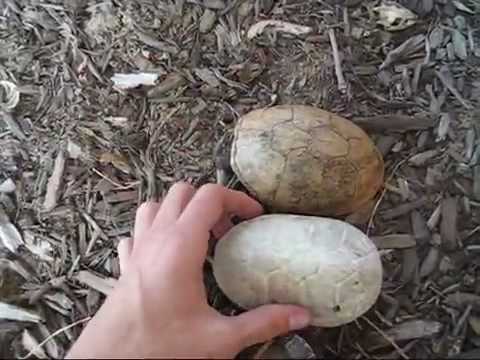To clean a dead turtle shell, gently remove any remaining flesh and tissues. Soak the shell in warm, soapy water.
Cleaning a dead turtle shell is essential to preserve it properly and prevent any foul odors or deterioration. By following the right steps, you can ensure the shell remains intact and serves as a unique decorative item or educational piece.
Proper cleaning techniques also help in studying the anatomy and structure of turtles. We will discuss the step-by-step process of cleaning a dead turtle shell effectively. Let’s dive in and learn how to clean a dead turtle shell properly to maintain its integrity and beauty.

Credit: www.reddit.com
Supplies Needed
Supplies Needed:
Protective Gear
- Heavy-duty gloves
- Safety goggles
- Face mask
Cleaning Materials
- Bleach
- Bucket
- Scrubbing brush
- Water
- Soft cloths
Preparing The Shell
When it comes to preparing the shell of a dead turtle, it’s crucial to ensure thorough cleaning and drying to preserve the shell properly. The process involves removing any remaining tissue and sun-drying the shell. Let’s delve into the essential steps for preparing the turtle shell.
Removing Any Remaining Tissue
To start, carefully inspect the shell for any remaining tissue or debris. Using a pair of gloves and a soft-bristled brush, gently remove any remaining tissue from the shell’s surface. Be cautious to avoid damaging the shell while cleaning. Ensure that all tissue and debris are thoroughly removed to prevent any odors or decay during the drying process.
Sun-drying The Shell
After the shell is free of any remaining tissue, it’s time to sun-dry it. Find a clean, dry area with direct sunlight exposure. Place the turtle shell in an area where it can receive ample sunlight and air circulation. Rotate the shell periodically to ensure even drying. Monitor the shell closely and protect it from any potential damage or disturbance during the drying process. Once the shell is completely dry, it will be ready for display or further preservation.
Cleaning Process
To clean a dead turtle shell, begin by gently removing any remaining flesh and tissue. Next, soak the shell in a mixture of water and mild dish soap to loosen any remaining debris. Then, carefully scrub the shell with a soft-bristled brush to remove any stubborn dirt or residue.
Rinse thoroughly and allow it to dry completely before displaying or using for educational purposes.
Cleaning a dead turtle shell is a sensitive process that requires patience and attention to detail. It is crucial to ensure that the cleaning process is done correctly to preserve the beauty and integrity of the shell. Here are the steps on how to clean a dead turtle shell.Scrubbing The Shell
The first step in cleaning a dead turtle shell is scrubbing the shell. You can use a soft-bristled brush or a toothbrush to gently remove any dirt or debris that may be stuck on the shell. Be careful not to damage the shell while scrubbing.Soaking The Shell In A Mild Detergent Solution
After scrubbing the shell, the next step is to soak it in a mild detergent solution. This will help to remove any remaining dirt or debris and disinfect the shell. To make the solution, mix a few drops of mild detergent in a bucket of water. Place the shell in the solution and let it soak for a few hours.Rinsing The Shell
Once the shell has soaked for a few hours, remove it from the solution and rinse it thoroughly with clean water. Be sure to remove all the soap residue from the shell.Drying The Shell
After rinsing the shell, dry it using a soft cloth or towel. Do not use a hairdryer or any other heating device to dry the shell. Place the shell in a cool, dry place and let it air dry naturally.Polishing The Shell
Once the shell is dry, you can use a soft cloth to polish it gently. You can use a commercial turtle shell polish or make your own by mixing equal parts of mineral oil and vinegar. Apply the polish to the shell and rub gently until the shell shines.Storing The Shell
After polishing the shell, store it in a cool, dry place away from direct sunlight. You can wrap it in a soft cloth or place it in a display case to protect it from dust and other debris. Cleaning a dead turtle shell can be a rewarding experience. With the right tools and techniques, you can bring back the beauty of the shell and preserve it for years to come.
Credit: animals.mom.com
Whitening The Shell
When it comes to cleaning a dead turtle shell, whitening the shell is an important step to restore its natural appearance and beauty. Here are two effective methods for whitening the shell: using hydrogen peroxide and applying a bleach solution.
Using Hydrogen Peroxide
Hydrogen peroxide is a gentle yet effective whitening agent that can help restore the natural color of a turtle shell. Follow these steps to use hydrogen peroxide:
- Clean the shell by removing any debris or organic matter.
- Prepare a solution of 3% hydrogen peroxide and water in a 1:1 ratio.
- Apply the solution to the shell using a soft brush or cloth, ensuring that the entire surface is covered.
- Allow the solution to sit on the shell for 24-48 hours, periodically checking the progress.
- Rinse the shell thoroughly with water to remove any residual hydrogen peroxide.
Applying A Bleach Solution
Another method for whitening a turtle shell involves using a bleach solution. Here’s how to apply a bleach solution to whiten the shell:
- Mix a solution of 1 part bleach to 9 parts water in a well-ventilated area.
- Wear protective gloves and use a soft brush or cloth to apply the bleach solution to the shell.
- Allow the bleach solution to sit on the shell for 15-30 minutes, monitoring the color change closely.
- Rinse the shell thoroughly with water to remove any residual bleach.
- Ensure the shell is completely dry before proceeding with any additional restoration or preservation steps.
Drying And Finishing
After the dead turtle shell has been thoroughly cleaned, the next step is to dry and finish it to ensure long-term preservation. This step is crucial in maintaining the integrity of the shell and preventing decay.
Air-drying The Shell
To begin the drying process, place the cleaned turtle shell in a well-ventilated area away from direct sunlight and heat sources. Ensure that it is positioned in a way that allows for adequate airflow around the entire shell. This will facilitate the evaporation of any remaining moisture and help prevent mold or mildew from forming during the drying process.
Applying A Protective Finish
Once the turtle shell is completely dry, it’s important to apply a protective finish to safeguard it from damage and degradation. Select a high-quality shellac or varnish that is specifically designed for use on natural materials. Carefully apply the finish using a soft brush, ensuring an even and thorough coating over the entire surface of the shell. This protective layer will help preserve the shell and enhance its natural beauty.

Credit: georgiaanddaughter.wordpress.com
Display And Preservation
To clean a dead turtle shell, gently remove debris with a soft brush. Use a mild soap solution and warm water to clean the shell, taking care not to damage it. Allow the shell to air dry completely before displaying or storing it.
Cleaning a dead turtle shell is not just about removing dirt and grime. It is also about displaying and preserving the shell in the best possible way. If you want to showcase the beauty of a turtle shell, you need to know how to properly display and preserve it. In this post, we will look at some display options and preservation techniques that will help you make the most of your turtle shell.Display Options
There are different ways to display a turtle shell. Depending on the size of the shell and your personal preference, you can choose from the following display options:| Option | Description |
|---|---|
| Wall mount | You can mount the shell on a wall using a sturdy bracket or hook. This is a great option for larger shells. |
| Stand | You can place the shell on a stand or pedestal. This is a good option for smaller shells. |
| Enclosure | You can display the shell in a glass enclosure. This is a good option if you want to protect the shell from dust and damage. |
Preservation Techniques
Preserving a turtle shell involves preventing decay and deterioration. Here are some preservation techniques you can use:- Dehydration: Remove any remaining flesh from the shell and let it dry in the sun for several days. This will remove any moisture from the shell and prevent decay.
- Bleaching: To whiten the shell, you can use a mixture of hydrogen peroxide and water. Apply the mixture to the shell and let it sit for a few hours before rinsing it off.
- Coating: You can apply a coat of clear acrylic spray to protect the shell from damage and discoloration.
- Storage: Store the shell in a dry and cool place, away from direct sunlight and moisture.
Conclusion
Properly cleaning a dead turtle shell is crucial for preserving it. Remember to use gentle methods and avoid harsh chemicals. By following these steps, you can maintain the shell’s integrity and beauty for years to come. Take care and respect nature’s creatures.
Happy cleaning!






Leave a Reply